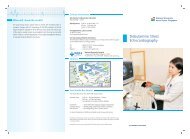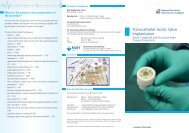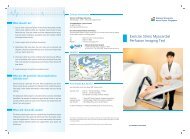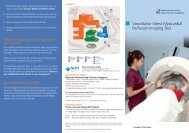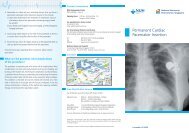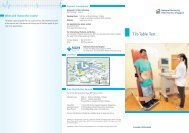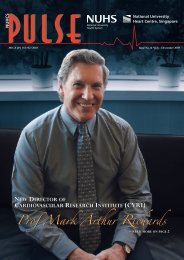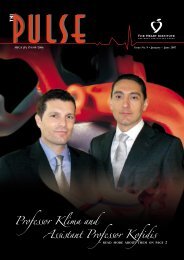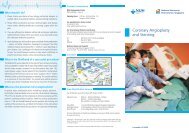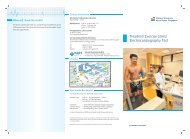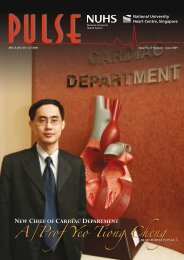2011 July - December - nuhcs
2011 July - December - nuhcs
2011 July - December - nuhcs
- No tags were found...
Create successful ePaper yourself
Turn your PDF publications into a flip-book with our unique Google optimized e-Paper software.
Bioabsorbable Stent:A/Prof Tan Huay CheemOn 17 Feb <strong>2011</strong>, NUHCS carried out Singapore’s firstimplantation of a bioabsorbable stent as part of an internationalmulticentre study. Since then, another 2 patients have receivedsuccessful implantations of the same stent. All three patients arewell at 6 months of follow up. NUHCS has been identified as aCentre of Excellence for the launch of the bioabsorbable stent andwill be among the first centre in Asia to use it on a commercial basisfor her patients before the end of <strong>2011</strong>.What is the bioabsorbable stent and why is there a need forit? The coronary stent is now the default device in modern daypercutaneous coronary intervention. Unlike in conventional balloonangioplasty, the coronary stent provides a mechanical scaffoldingeffect to overcome early recoil and late vascular remodeling(vasoconstriction) of a treated coronary vessel. The currentstate-of-the-art drug-eluting stents (DES) are highly efficacious inreducing restenosis rates and the need for repeat intervention. Stentthrombosis, with its disastrous consequences, however, remains amajor limitation of DES. It may be somewhat controlled with dualantiplatelet therapy, which is usually given for at least a year afterthe procedure. But the presence of metallic material embedded inthe vessel wall may still cause chronic inflammation and result invery late stent thrombosis (occurring beyond a year). There is noadvantage for a stent to be permanently present in the artery afterit has served its initial function of scaffolding, while allowing forvascular healing and re-endothelialization to take place. In fact, themetallic stent prevents the artery from late favorable remodeling(lumen expansion) and vessel reactivity at the stented site.The motivation for the development of bioabsorbable stentswas driven by the need to solve the limitations of metallic stents,such as stent thrombosis, which requires prolonged antiplatelettherapy. The goal was to design a stent, which once bioabsorbedwould leave behind only the healed natural vessel, and allowingfor restoration of vasoreactivity with the potential for vesselremodeling. The concept is particularly attractive to young patientswho suffer from coronary artery disease but are now given theopportunity to have their arteries restored to their original stateafter treatment. Late stent thrombosis is unlikely since the stent isgone, and prolonged antiplatelet therapy would not be required.These stents can also be used for delivery of drugs that can preventneointimal hyperplasia. Bioabsorbable stents are compatible withMRI and MSCT imaging.The development of the bioabsorbable stent is a challengingone. The ideal polymer, degradation time and degradation rateto allow vessel support healing and prevention of acute recoiland late vessel remodeling have to be found. Many bioabsorbablestents have been developed but failed to go beyond initial firstin-manevaluation phase. The only one to make it to commercialutilization and thus far, approved by European CE regulatory bodyis the Bioresorbable Vascular Scaffold (BVS Abbott Vascular, SantaClara, California). Made of thick strut poly-L-lactide, with anotherlactide acting as a controlled release polymer coating, the stentelutes an antiproliferative drug, everolimus, to prevent smoothmuscle cell proliferation. The stent has gone into a second iteration(BVS1.1) with the improved version providing better scaffolddesign and performance. The angiographic late loss, a parameterof vascular biologic response, amounted to 0.27+/-0.32mm,which is comparable with current best DESs.The bioabsorbable stent represents another breakthrough inthe technological evolution of the coronary stent, and a potentialgame changer in the industry of stent design and materials. We areproud to provide this technology to our suitable patients.NUHCS PULSE | 15



